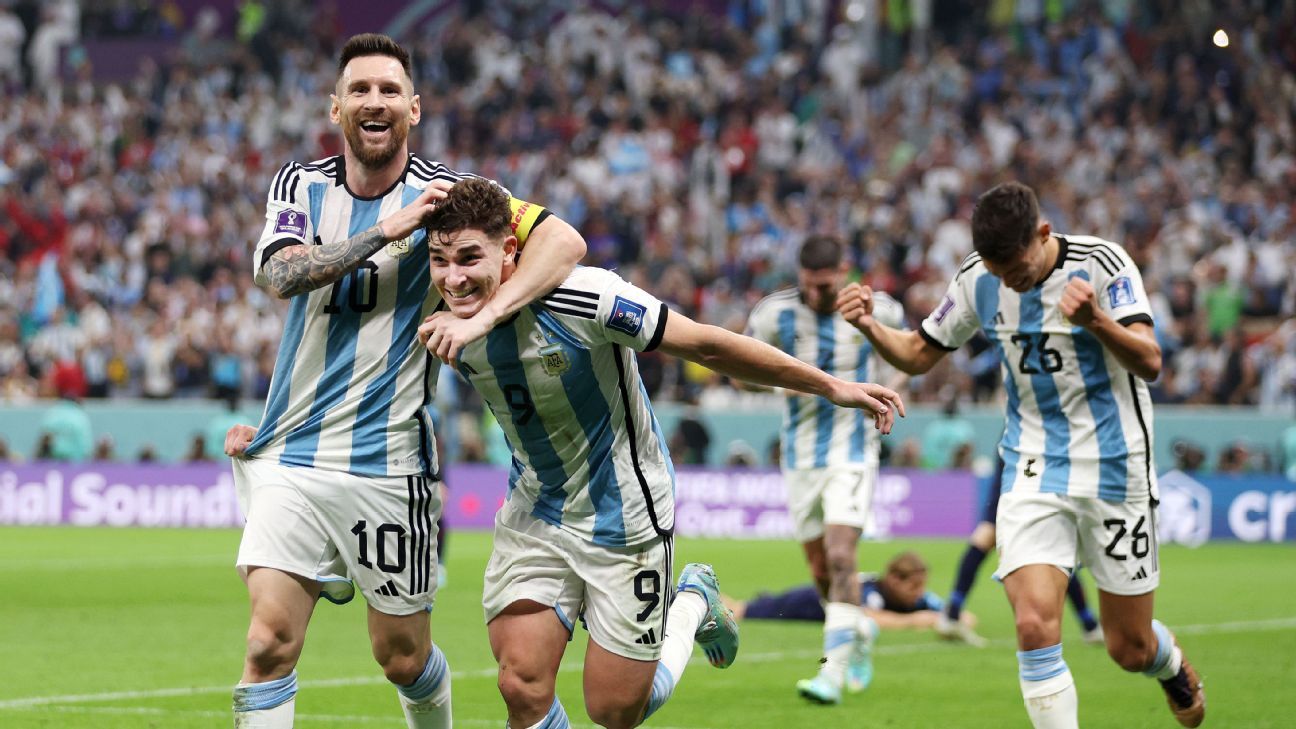AL DAAYEN, Qatar — Knockout tournaments like the World Cup generally require you to finish strong, unlike, say, a league format where you can build up a big lead at the start and hobble first across the finish line. Argentina evidently got the message. On the night that Lionel Messi scored his 11th World Cup goal (surpassing Gabriel Batistuta for most in the country’s men’s tournament history) in his 25th World Cup match (equaling Lothar Matthaus) they reached their sixth World Cup final in the most convincing way possible.
Argentina came out for their pre-match warmup with the swagger of a pro wrestler, as the Lusail Stadium DJ played Rodrigo’s “La Mano de Dios,” the homage to Diego Maradona set to a “cumbia” beat. And, as with a pro wrestler’s entrance music, the mostly Albiceleste crowd dutifully popped.
Big entrances, though, mean little when they are not backed up by big performances. Argentina had, in fact, been getting better as the tournament wore on. Apart from the third group game against Poland, though, they had failed to put together a 90-minute performance, letting a two-goal margin slip against the Netherlands in the quarterfinals (they eventually advanced on penalties) and nearly doing the same against Australia in the round of 16.
– World Cup 2022: News and features | Bracket | Schedule
Tuesday night at Lusail Iconic Stadium was different. This was comprehensive. This was confident. This was control. And, while Messi opened the scoring from the spot and provided a ridiculous moment of skill in setting up the third goal, this was a team performance. Whatever Messi dependency may have afflicted them in the past was cured on the night. He was merely the cherry on top.
Argentina boss Lionel Scaloni knew how Croatia were going to play. His counterpart Zlatko Dalic made no secret of it. In his view, he had the “best midfield in the world” in Luka Modric, Mateo Kovacic and Marcelo Brozovic, and he was going to use it to control the game as much as he could. It was the gameplan that worked so well against Brazil: make the opposition chase you when you have the ball, not least because, if you have possession, the other guys can’t score on you.
To counter the threat, Argentina switched to a back four and a de facto diamond in midfield. Out went Lisandro Martinez at the back, in came Leandro Paredes, a ball-playing defensive midfielder. With Rodrigo De Paul, Enzo Fernandez and Alexis Mac Allister, it not only meant they had an extra man in the middle to counter Croatia’s trio, they also had a midfield that could ratchet up the intensity.
That mattered against a Croatia side who is older and who had gone to penalties twice in the preceding rounds. Just after the half-hour mark, Fernandez’s through-ball found Julian Alvarez, who was brought down by Dominik Livakovic in the box. Messi converted from the spot.
Moments later, Argentina got a dose of good fortune, but of the sort that favors the brave. Alvarez picked up a loose ball near halfway and powered forward on the counter like a runaway freight train. The ball caromed off Josko Gvardiol (twice) and then Borna Sosa and yet, as if by magic, remained in Alvarez’s path for him to poke home.
Argentina were up 2-0 and on their way. In fact, they could have made it three before the break but Livakovic was alert on Nicolas Tagliafico‘s near-post header.
Dalic is a never-say-die guy, but also a realist. He clearly realized that his midfield triangles weren’t going to get Croatia back into the game, and by the fifth minute of the second half, he had sent on two wingers (Mislav Orsic and Nikola Vlasic) and a burly center-forward (Bruno Petkovic) while taking off his midfield general in Brozovic. Croatia were going to go direct.
Scaloni countered Dalic’s chess move with one of his own. Out came Paredes, in went Martinez, giving Argentina a back three and extra bodies to counter the inevitable aerial assault.
Argentina were comfortable and organized and could launch counters. And then, of course, there was the Messi factor: the fact that anywhere, at any time, he can do something unthinkable. With 20 minutes to go, he received the ball in transition, wide right around the halfway mark, with Gvardiol on his heels.
This was 35-year-old Messi against Gvardiol, who is not just 15 years Messi’s junior but also one of the best young defenders in Europe. You expect Messi to conjure up some sort of footwork trickery to find space, or maybe see (and pull off) a pass that nobody else sees. You do not expect him to take the young’un for a ride.
But that’s what he did.
Messi went on one of those runs were he appears to take 10 steps a second, with Gvardiol on top of him, matching him step for step. A shimmy, a stop-start, Messi couldn’t shake his mark, though. Still, the ball remained glued to his foot. A dragback, a pirouette, and still Gvardiol was there, impossible to lose, like the reflection in a mirror. And so Messi faked one way and went the other, legs pumping ever faster, and somehow dribbled around Gvardiol, the way he might have done around a thousand and one orange cones in training as a child. This was a feat as athletic as it was technical. It’s not what you expect from a veteran. But then, Messi is Messi.
He capped it off with a simple square ball into the box, which the waiting Alvarez side-footed home and that was that. Except, of course, for the highlight-reel memory of an unreal piece of skill that has probably already been turned into a GIF.
